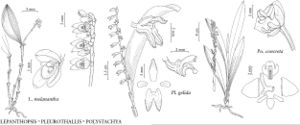Pleurothallis
in W. Aiton and W. T. Aiton, Hortus Kew. 5: 211. 1813.
Herbs epiphytic. Roots fibrous. Stems erect, stout; sheaths tubular, variously enclosing stems. Leaves 1, erect, sessile or petiolate; blade leathery. Inflorescences terminal [axillary], 1–several lax or clustered racemes [solitary flower]. Flowers sometimes distichous, resupinate, opening simultaneously; sepals distinct [variously connate], subequal, membranous [thickly fleshy], pubescent [smooth or verrucose]; petals glabrous [verrucose, papillose, pubescent, ciliate, or fringed]; lip simple [2–5-lobed], membranous [thickly fleshy], callous, base loosely articulate to base of column or apex of column-foot [sometimes inflexibly adnate]; column semiterete, stout [slender], winged [wingless], with or without column-foot, apex with anther exposed or hooded; anther apical or adaxial; ovary articulate between ovary and minute curved pedicel; pollinia 2, pyriform with viscidium [spheric without viscidium] and caudicles [naked, with or without viscidium]; stigma adaxial [apical], 1–2-lobed; rostellum apical or adaxial. Fruits capsules, deciduous at pedicel (ca. 1 mm), ellipsoid, 3-valved.
Distribution
Tropics, s Fla., s Mexico, West Indies, Central America, South America
Discussion
Species ca. 2500 (1 in the flora).
Pleurothallis is the largest genus in the subtribe Pleurothallidinae, and perhaps in the Orchidaceae.
Selected References
None.
